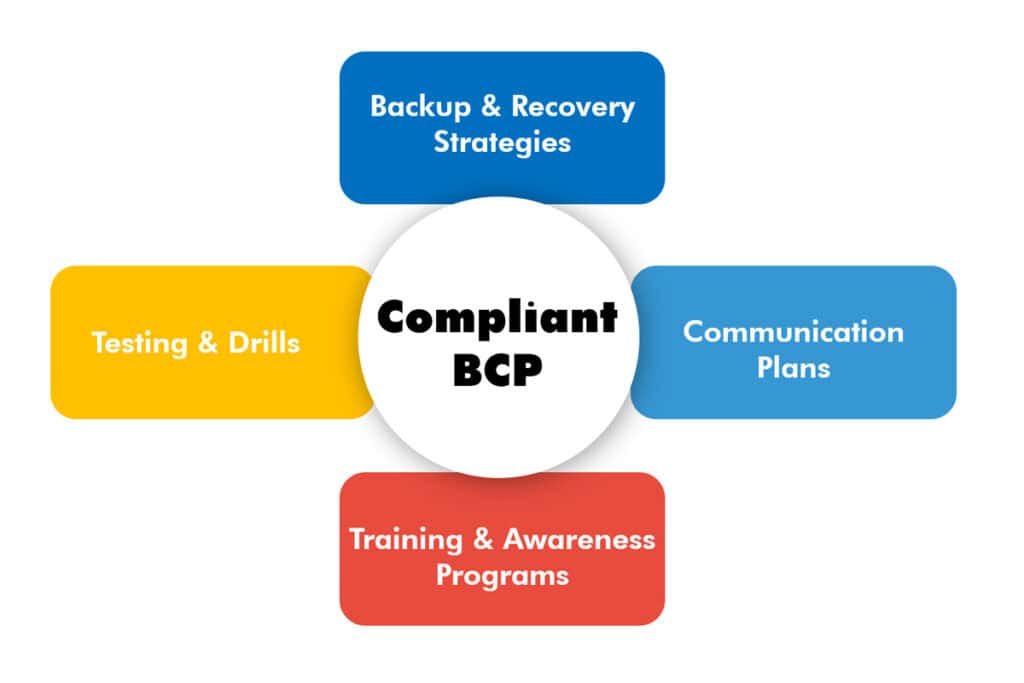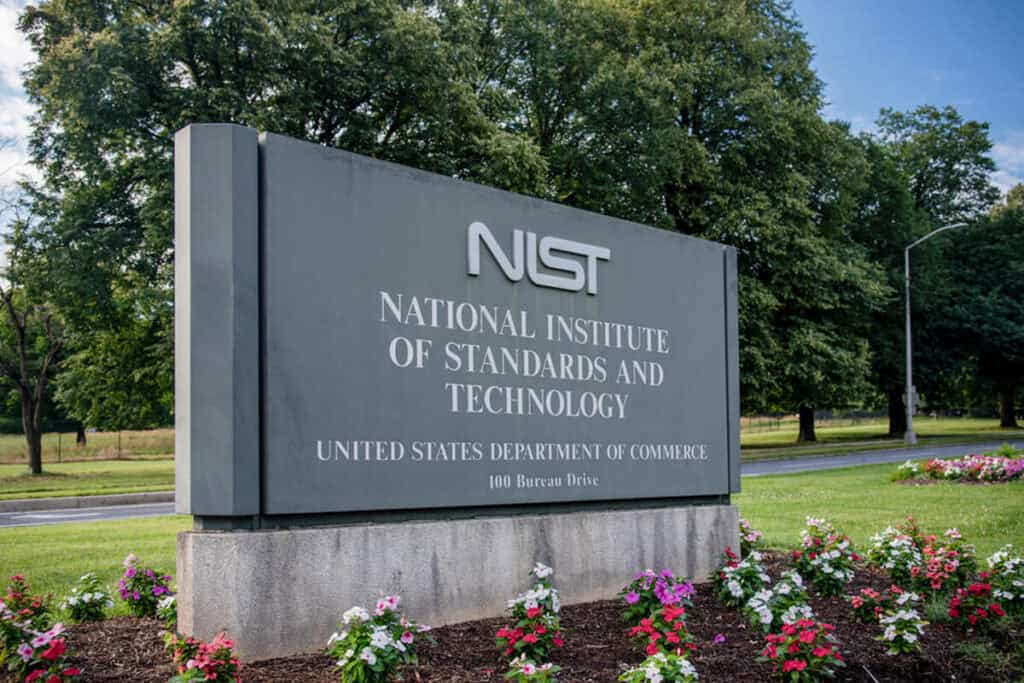Key Highlights
- Organizations use a business continuity plan (BCP) to maintain operations during and after a disaster or severe disruption.
- The BCP outlines procedures and instructions to minimize financial and reputational losses and ensure the safety of employees.
- Regulatory compliance is a critical aspect of business continuity planning. Organizations must adhere to specific requirements to protect sensitive data and meet industry standards.
- Key regulations and standards impacting BCP include the Federal Information Security Modernization Act and the Financial Industry Regulatory Authority.
- Essential components of a compliant BCP include data backup and recovery strategies, effective communication plans, and alignment with global standards such as ISO 22301 and the NIST Cybersecurity Framework.
Table of Contents
ToggleIntroduction
A Business Continuity Plan (BCP) helps organizations maintain stability during risks like natural disasters or cyberattacks. It outlines how a company will operate during disruptions, ensuring employee safety and critical operations. Without a BCP, these threats can disrupt business operations at any time, impacting revenue and causing a loss of reputation.
This blog explores regulatory compliance in BCP, key regulations impacting it, essential components, industry-specific requirements, and aligning with global standards for resilience during disruptions.

Why Do We Need a Plan for Business Continuity Regulatory Compliance?
A business continuity plan is essential for operations during disasters and regulatory compliance. It safeguards data, ensures customer privacy, and complies with laws such as HIPAA and FINRA. Moreover, a BCP provides a competitive advantage by demonstrating security measures and risk management practices.
Lastly, a BCP serves as the foundation for disaster recovery efforts. It enables swift recovery of critical systems, resumption of operations, and minimization of downtime by guiding leaders and employees in effective disaster response.

Regulatory Compliance in Business Continuity Planning
Regulatory compliance is essential for business continuity planning, ensuring organizations meet requirements to safeguard operations. This involves assessing risks like natural disasters and cyber breaches. Senior management oversees execution, demonstrating a commitment to compliance.
Aligning planning with regulations ensures preparedness for disruptions. Effective communication manages stakeholder expectations and transparency. Compliance in continuity planning protects operations, meets standards, and builds trust. Integrating regulations into BCP development ensures resilience during disruptions.

Overview of Key Regulations and Standards Impacting BCP
Companies must know regulations and standards when engaged in business continuity planning. They must adhere to these regulations to protect sensitive data, ensure the security of operations, and meet industry standards even when a disaster or threat occurs.
One way to be sure they can do so is to conduct a Business Impact Analysis (BIA). The Business Impact Analysis is crucial for business continuity planning and compliance. It assesses the impact of disruptions on critical functions, prioritizes resources, and aids recovery efforts. Conducting a BIA helps organizations identify and mitigate risks to ensure operational continuity.
Let’s explore some of the key regulations and standards impacting BCP:
- FINRA (Financial Industry Regulatory Authority) compliance ensures data security, operational integrity, and regulatory adherence for broker-dealer firms. Organizations in the financial sector must consider these regulations when they conduct business continuity planning to ensure they can meet them in the event of a natural disaster or security breach.
- Federal Information Security Modernization Act (FISMA) sets federal government information security guidelines. Compliance is crucial for organizations serving the government or handling sensitive data. Business continuity plans must meet FISMA standards for operational security and resilience.
- Compliance Standards like ISO 22301 and the NIST Cybersecurity Framework offer guidelines for business continuity planning.
- ISO 22301 sets international standards for continuity management systems, ensuring resilience during disruptions.
- The NIST Cybersecurity Framework manages and mitigates cybersecurity risks, which is crucial for continuity planning.
Compliance with these regulations protects organizations from legal and financial consequences and helps build trust and confidence among stakeholders.

Essential Components of a Compliant Business Continuity Plan (BCP)
A compliant business continuity plan (BCP) should consider several essential components to ensure its effectiveness and ensure regulatory compliance.
These components include:
- Data Backup and Recovery Strategies: A BCP should outline data backup and recovery strategies to ensure the availability and integrity of critical data. This includes establishing backup systems, defining recovery point objectives (RPOs), and implementing disaster recovery plans.
- Effective Communication Plans During Disruption: Communication is crucial during a disruption to ensure the timely and accurate exchange of information with stakeholders. A BCP should include communication plans that outline steps and protocols for communicating with employees, customers, suppliers, and other relevant parties.
- Training and Awareness Programs: Regular training sessions and awareness programs are essential to educate employees on their roles and responsibilities during a crisis. This ensures everyone is prepared and knows what actions to take in different scenarios.
- Testing and Exercises: Regular testing and evaluation of the BCP through simulations and exercises are critical to identify any gaps or weaknesses in the plan. This allows for fine-tuning and continuous improvement of the BCP.

Resilience: Using Data Backup and Recovery Strategies to Reduce Downtime
Data backup and recovery strategies are essential to a compliant business continuity plan. These strategies ensure the availability and integrity of critical data during and after a disruption.
Critical considerations for data backup and recovery include:
- Establishing backup systems and infrastructure to store and protect critical data.
- Implementing a disaster recovery plan to outline steps for recovering data and systems.
Defining recovery point objectives (RPOs) to determine the acceptable data loss during recovery.
- Regularly testing and evaluating the effectiveness of data backup and recovery procedures.
- Ensuring data backups are securely stored and can be accessed quickly during a disruption.
Where loss of data is not an option, organizations should consider using cloud backup solutions or cloud storage solutions to ensure the resiliency of their data storage architecture.

Effective Communication Plans During Disruption
Effective communication plans are crucial during a disruption to ensure the timely and accurate exchange of information with stakeholders.
Organizations should develop comprehensive communication plans that consider the following:
- Identify key stakeholders
- Establish communication protocols and channels
- Provide clear instructions and guidance for internal and external communication
- Maintain accurate stakeholder contact information
- Conduct regular training and awareness programs
Specific Industry Compliance Requirements
Due to their sensitive nature, certain industries rely on specific compliance requirements. Organizations must tailor their business continuity plans to meet these industry-specific regulations when these are present.
Here are some examples of compliance requirements in specific industries.
HIPAA Compliance Challenges in the Healthcare Sector
Compliance in the healthcare sector often revolves around the complexities of handling sensitive patient data while ensuring business continuity. Organizations must balance regulatory requirements like HIPAA and maintaining operational efficiency.
Moreover, integrating disaster recovery and data protection measures within the stringent regulatory framework adds another layer of complexity. Healthcare organizations must navigate these challenges to safeguard patient information, uphold compliance standards, and maintain uninterrupted operations amidst evolving threats and regulations, especially during emergencies.
Financial Services: Adhering to FINRA and Other Regulations
The financial industry regulatory authority, FINRA, sets specific standards that financial institutions must follow to ensure regulatory compliance. Adhering to regulations safeguards sensitive data and enhances credibility and trust with stakeholders.
It is imperative for financial organizations to stay abreast of evolving compliance standards to mitigate risks effectively and uphold the integrity of the financial system.
Aligning Your BCP with Global Standards
Aligning your business continuity plan (BCP) with global standards is crucial for ensuring best practices, consistency, and regulatory compliance. Two global standards that provide guidance for BCP are ISO 22301 and the NIST Cybersecurity Framework. Here’s how these standards can help align your BCP:

ISO 22301: Business Continuity Management Systems
The ISO 22301 standard is a global standard for business continuity planning. The standard helps organizations ensure resilience and continuity during disruptions. Compliance improves efficiency and builds stakeholder confidence, demonstrating a commitment to preparedness. ISO 22301 enhances an organization’s ability to navigate risk and protect business interests.

Leveraging the NIST Cybersecurity Framework for BCP
Implementing the NIST Cybersecurity Framework in your Business Continuity Plan enhances cyber resilience. By aligning with NIST guidelines, organizations strengthen their cybersecurity posture, mitigating risks of cyber threats during disruptions.
The framework offers a structured approach to cybersecurity, focusing on identifying, protecting, detecting, responding to, and recovering from incidents. Leveraging the NIST Cybersecurity Framework and the guidelines set by the National Institute of Standards and Technology (NIST) through executive orders ensures a proactive and systematic response to cyber risks, safeguarding data and maintaining operational continuity amid evolving threats from local governments.
Regional Compliance Considerations for BCP
Organizations must also consider regional compliance requirements when developing a business continuity plan (BCP). These requirements vary based on local laws, governmental policies, and industry-specific regulations. Organizations should tailor their BCP to meet these regional compliance considerations.
Key factors to consider include:
- Compliance with local data protection regulations, such as the European Union’s General Data Protection Regulation (GDPR).
- Understanding and adhering to governmental policies and guidelines for disaster planning and response.
- Adhering to industry-specific regulations and standards that apply to the region.
Overcoming Common Compliance Challenges
Achieving business continuity regulatory compliance is challenging.
Organizations can overcome this by being proactive and following best practices. Common challenges include changing regulations and a lack of employee awareness. To address these, leaders must stay informed, provide regular training, and invest in automation and data security technology solutions.
Compliance with business continuity regulations, which ensure the smooth operation of critical business functions, should be viewed as a competitive advantage that enhances efficiency and risk management in business continuity planning.
Utilizing Technology and AI to Meet Compliance Mandates
Technology plays a crucial role in meeting compliance mandates in business continuity planning. Organizations can utilize various technologies to ensure compliance and enhance their overall resilience.
Some key technologies include:
Artificial Intelligence (AI) and Machine Learning (ML):
These technologies can help organizations detect patterns and anomalies indicating noncompliance or potential cyberattacks. AI can proactively identify risks and take preventive measures by analyzing large amounts of data.
Data protection and encryption
Organizations should implement robust data protection measures, including encryption and secure storage, to ensure compliance with data protection regulations. This helps protect sensitive data from unauthorized access and ensures its integrity and confidentiality.
Cybersecurity solutions
Advanced cybersecurity solutions, such as firewalls, intrusion detection systems, and endpoint protection, are essential for protecting against cyberattacks. These technologies can help organizations detect and prevent security breaches, minimizing the risk of noncompliance.
Cloud computing
Cloud-based solutions offer scalability, flexibility, and enhanced security for business continuity planning. By leveraging cloud technology, organizations can securely store and access critical data and applications, ensuring compliance and resilience.
Strategies for Regular Audits, Testing, and Updates
Regular audits, testing, and updates are essential for maintaining compliance and ensuring preparedness in business continuity planning.
Here are some key strategies:
- Regular audits: Regular audits of the business continuity plan help identify gaps or weaknesses, ensuring it remains up-to-date and compliant with regulations. Audits should assess the plan’s effectiveness, evaluate the implementation of best practices, and identify areas for improvement.
- Tabletop exercises: These drills involve simulating potential disaster scenarios and walking through the steps outlined in the business continuity plan. They help identify gaps in the plan, test the effectiveness of communication and response procedures, and enhance overall preparedness.
- Updates: It is crucial to regularly review and update the business continuity plan to reflect changes in the organization’s operations, infrastructure, policies, or regulations. This includes updating the plan when roles change, after each test or exercise, and whenever there are significant changes that could impact the plan’s execution.
Regular audits, tabletop exercises, and updates ensure that the business continuity plan remains effective, compliant, and aligned with the organization’s evolving needs and regulatory requirements.
Involving Business Stakeholders in Compliance
Maintaining organizational compliance takes effort. All staff must be trained in regulatory procedures. This requires ensuring that department heads, executives, and other key stakeholders are involved in regulatory planning and execution.
Conclusion
Achieving business continuity regulatory compliance is essential for the success and longevity of your business. You can effectively address industry-specific challenges by staying informed about regulations, incorporating necessary components into your BCP, and adhering to global standards. Additionally, embracing technology, conducting regular audits, and staying updated are crucial steps for achieving compliance success. Remember, compliance is an ongoing commitment that requires vigilance and adaptability to protect your business and stakeholders. By remaining proactive and informed, you can ensure that your BCP can withstand the ever-changing regulatory landscape.




